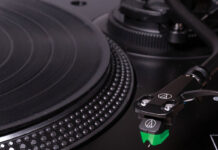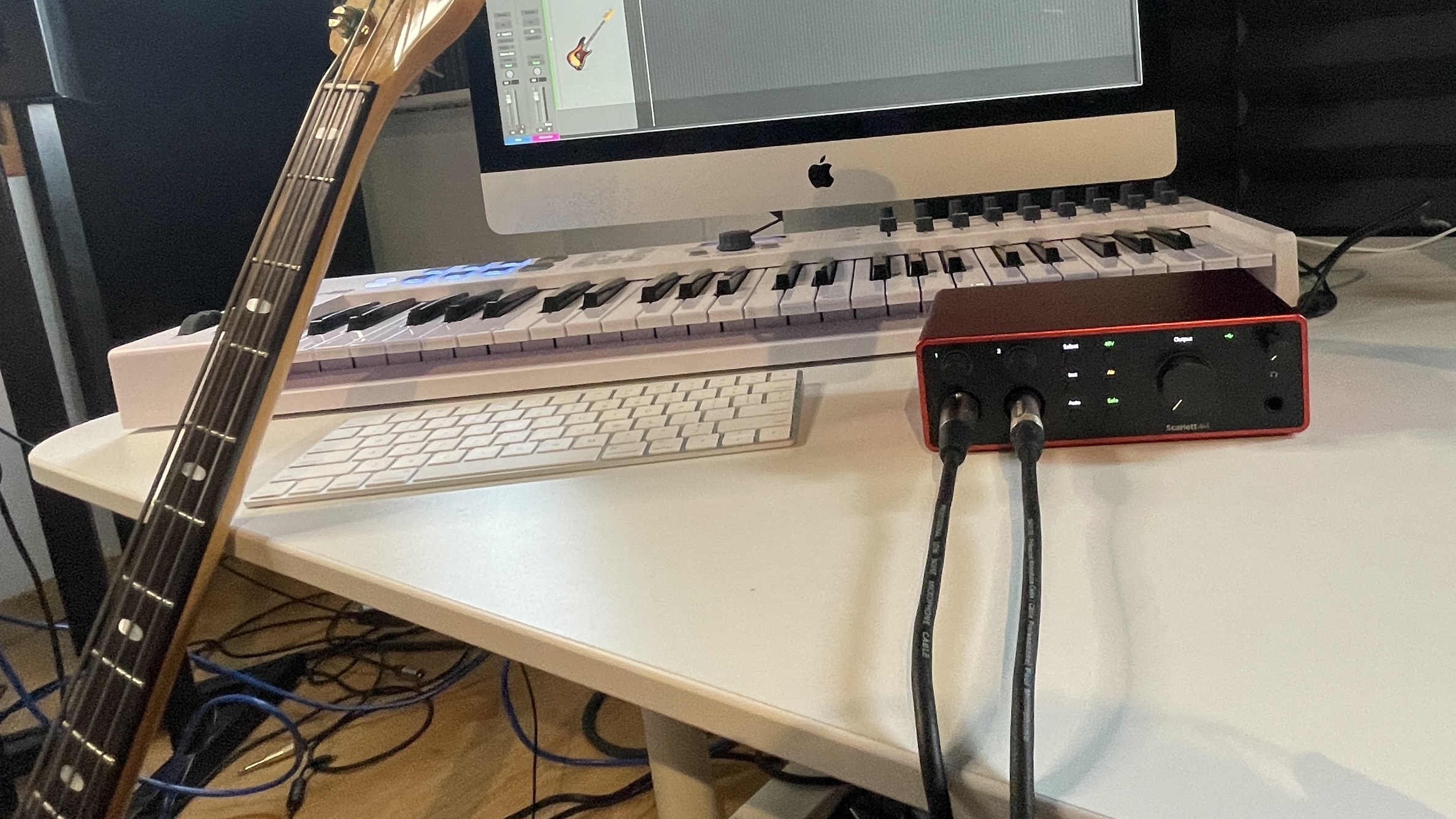
In today’s post, I review Focusrite’s 4th-generation Scarlett 4i4 audio interface. The Scarlett series is one of the most popular audio interfaces on the market, and the 4th-generation model contains more features than ever. In this review, I will cover the many features available with this edition of the Scarlett 4i4, elaborate on the value of these features, as well as offer my overall opinion on the unit.
Focusrite Scarlett 4i4 interface overview
The Scarlett 4i4 4th-generation is a complete audio interface for creative musicians. At its base, the 4i4 features four inputs, four outputs and a MIDI in/out connection, all of which combine to offer a myriad of recording options for voice, guitars, synths, outboard gear, and other instruments.
Supplementing the base layer of features are two revamped Focusrite microphone preamps, analogue-style signal processing options, and a multitude of software choices to help you create and produce your best music or audio production.
I would like to offer some background for my Scarlett 4i4 review. I have reviewed many of Focusrtite’s audio interfaces in the past, and am also a Focusrite audio interface owner. As such, I follow closely the differences and improvements available with each new generation of interface. I think you will find impressive what the 4th-generation Scarlett interface offers.
Scarlett 4i4 inputs and revamped preamps
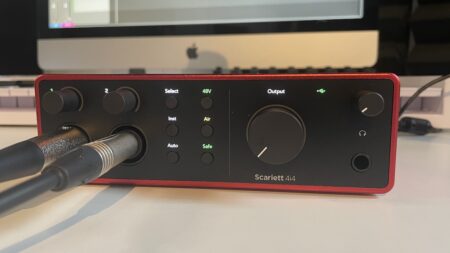
The Scarlett 4i4 offers flexibility for your recording needs via a comfortable range of input and output options. Two of the four inputs (Inupts 1 and 2) are hybrid XLR-1/4-inch connections, mounted on the front of the unit and connecting directly to revamped Focusrite 4th-generation preamps. Focusrite has an amazing reputation for the quality of its preamps. This newest update to the preamp is super clean (very low noise), and has up to +69dB of gain available.
The 69dB of gain is a significant improvement, allowing for the use of both dynamic and condenser styles of microphones with no issue whatsoever. So far as sound quality is concerned, the preamps are nothing short of amazing. They offer a bountiful, rich sound no matter the sound source. Personally, I love the sound of my electric bass when plugged into the Focusrite preamp.
Inputs 1 and 2 are manageable via the front of the 4i4 unit and are also controllable via the Focusrite Control app, which is an important tool when working with the 4th-generation Scarlett 4i4. I will take a closer look at the Focusrite Control 2 App later in this review.
HI-Z or line inputs for guitars, synths, and more
On the rear panel are two more inputs, Inputs 3 and 4. These are 1/4-inch inputs (no XLR option), which make them an easy choice for guitar, synth, or keyboard recording. You might also use them as a L/R input for a drum machine, or perhaps as a return for outboard effects as well.
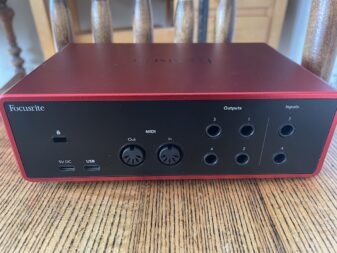
Scarlett 4i4 outputs offer monitoring and send choices
The Scarlett 4i4 features four separate 1/4-inch outputs. It is a fair assumption that Outputs 1-2 would be used for studio monitoring, which leaves a certain amount of flexibility for the use of Outputs 3-4. If you have a second pair of studio reference monitors or wish to send your audio to outboard gear for sound processing, the output options are available to you.
Scatlett 4i4’s new features
Auto Gain
The 4th-generation Scarlett 4i4 audio interface integrates two new features to help you make better recordings. The first is the Auto Gain feature. On channels 1 and 2, Auto Gain helps set an ideal input volume (the “sweet spot”) for your recordings. Enable the Auto Gain, and a blue ring appears around the gain adjustment on the 4i4 interface. For the next 10 seconds, the Auto Gain analyses the sound input to establish an ideal setting.
You will need to talk into your mic or play your instrument during this time, but you will be happy with the result afterward. There will be little fussing around after the Auto Gain does its thing.
Clip Safe
If there are unforeseen audio peaks after the Auto Gain is set, enabling the Clip Safe feature protects those peaks from becoming audible digital distortion (clipping). The Clip Safe feature acts as an audio limiter, whose sound imprint is minimal yet very useful.
Updated Air Mode
The Air Mode came forth in the 3rd-Gen Scarlett interfaces. Now, with the 4th generation, you will find more options to help contour your sound when using Inputs 1 and 2. There are now two settings, Presence and Drive. The Presence setting adds a nice midrange sparkle to your sound, and the Drive adds saturation and heft.
Each setting has its own distinct advantage. The Drive sounds amazing on bass guitar, whereas the Presence can really bring to life a voice or acoustic guitar.
Scarlett 4i4 software and production tools
The Scarlett series features a large assortment of downloadable software apps and bundles to work with. They help you manage your sound and take your production quality up a notch.
Focusrite Control 2 app manages the 4i4
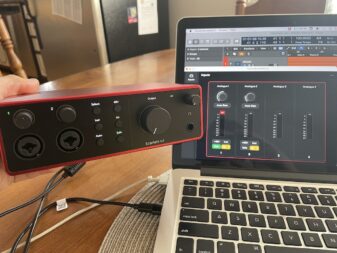
The primary, and perhaps the simplest app to use is Focusrite Control 2 (FC2). FC2 allows control of the Scarlett 4i4’s many features and also offers DSP (direct signal processing) monitoring and thus a few options for monitoring via the Scarlett interface.
Value via included plugins and virtual instruments
The Scarlett 4i4 includes the Focusrite Hitmaker Expansion pack. Here you will find an excellent rock drum set from Addictive Drums, a vocal doubler plugin effect from Sonnox, three plugins from Brainworks (Focusrite console, Bx_Masterdesk and Bx_Oberhausen soft synth), ReLab’s LX480 reverb plugin, Softube’s Marshall Silver amp, and Native Instrument’s Massive soft synth instrument as well.
There is no shortage of high-quality production tools available to you!
Included DAW software helps you get started
The Scarlett 4i4 audio interface also includes a selection of DAWs (digital audio workstations) to choose from. Primarily, a 3-month Pro Tools Artist subscription will help you to get started with your music-making. Pro Tools is the industry standard for DAWs, however, the Scarlett 4i4 is compatible with many other DAWs as well.
Focustire Scarlett 4i4 provides everything you need and more
To conclude this Focusrite Scarlett 4i4 review, I emphasize the quality of the product, seconded by the value of the additional software available. The 4th-generation Scarlett interface offers a noticeable improvement over its older 3rd-generation sibling. Improvements to preamps, Air function as well as the Auto Gain and Clip Safe features make for an excellent-sounding digital audio interface. The strength of the 4i4’s four inputs offers flexibility for today’s multi-faceted musical artists.
Key plugins and virtual instruments complete the package, and the overall resulting value of the Scarlett 4i4 is outstanding. Great sound, and great tools … it is all you need, and more.
What style of music will you produce with your Focusrite Scarlett 4i4? The Scarlett 4i4 digital audio interface is available now at Best Buy.



